Historic Buildings listed by the Tasmanian National Trust page 5
[Previous Post: National Trust Tasmanian Heritage Register 4.... Next Post: National Trust Tasmanian Heritage Register 6]Table of Contents
Georgian and Gothic Revival Style buildings forming the Heritage of Tasmania.
On this page:
83 - 95 of the 106 Properties listed in 1964 by the Tasmanian National Trust
 |  |  |
| Murray Street Hobart 1824-70 | Islington Hotel Hobart 1877 | Sunnyside New Town 1845 |
The Mercury Historic Homes Competition
- This photographic competition was held in 1963 to mark the 109th anniversary of the founding of the Mercury newspaper.
- The competition was sponsored by The Mercury and organised by the National Trust of Australia (Tasmania) southern region.
Entries 1 - 27 are on the First Page:
 |  |  |
| Lake House TAS | Shene Estate TAS | Redlands TAS |
Entries 28 - 53 are on the Second Page:
 |  |  |
| Ross Bridge | The Grange (1847) | Longford House |
Entries 54 - 64 are on the Third Page:
 |  |  |
| Govt. House, Hobart (1857) | Spikey Bridge, Swansea | Buckland Anglican Church (1846) |
Entries 65 - 82 are on the Fourth Page:
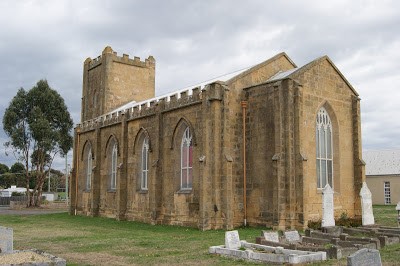 |  |  |
| St Matthew's Rokeby (1841) | Westella, Ulverstone (1885) | St David's Hobart (1893) |
These pages exist to remedy that terrible lack.
All 106 Properties are summarised on this page: National Trust Tasmanian Heritage Register
Military Camps
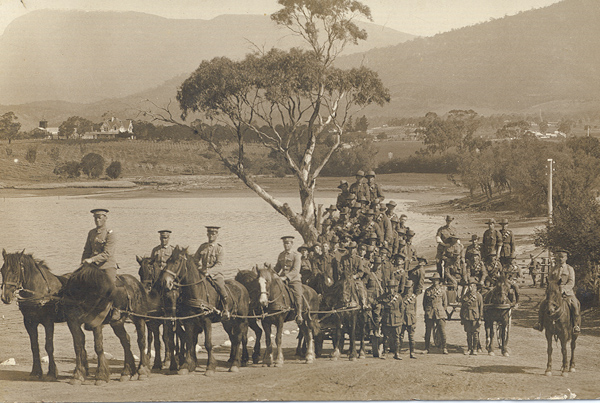 |
| Soldiers training at the Claremont Army Camp in the First World War |
Military Camps were at first tents for the many soldiers who arrived with British settlements to guard convicts. Gradually barracks were built, in Hobart (Anglesea Barracks, from 1814), Launceston (at changing sites, notably Paterson Barracks) and other towns.
Ruins can be seen at Oatlands, Richmond and Ross.
After the convict system ended, army strength declined, and when the British Army left in 1870, the militia which replaced it lived in their own homes, though Queen's, Kangaroo Bluff and Alexandra Batteries (1885) contained quarters for soldiers.
Training activities took place at camps, and a camp site at Mona Vale, Ross, was established in 1908 by its owners, the Cameron family.
83. The Gaol and Anglesea Barracks, Davey Street Hobart
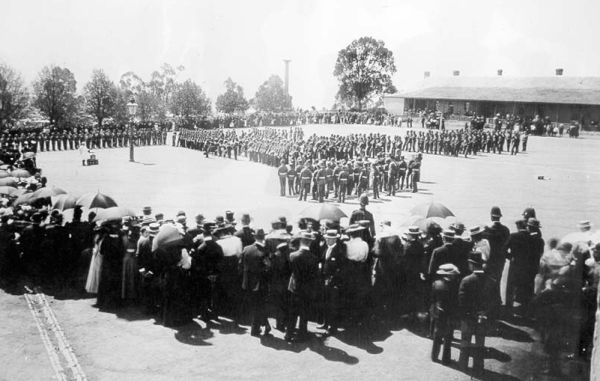 |
| A crowd watches soldiers on parade in 1899, during the South African War |
Most of the Anglesea Barracks then passed out of military control, except for a small portion retained for the volunteer forces raised during the 1850s, and a permanent military cadre staff.
Occupants of the remaining buildings included boys' and girls' schools, a girls' reformatory, aged women's home, gymnasium, weather bureau and the Royal Hobart Bowls Club.
- From 1898 the Ministry of Defence pressured for the return of the rented buildings, to permit occupation by an expanding defence force precipitated by the South African War (1899–1902), and the commencement of federal control. In 1901 responsibility for defence passed to the new Australian federal government.
- The Barracks passed back into full military control and has remained so ever since.
- The new Australian army resumed use of Anglesea Barracks in 1901, and troops for the South African War trained there until over-enthusiastic spectators inspired a move to a camp at New Town.
 |
| Hospital, Anglesea Barracks |
Architecturally, the Barracks can be divided into three phases: buildings erected between 1814 and 1838, made of convict brick; those from 1838 to 1870, mostly local sandstone; and those erected since the turn of the century.
- Anglesea Barracks, headquarters of the Australian Army, Navy and Air Force in Tasmania, is the oldest military establishment in Australia still occupied by the Army.
- On his visit to Van Diemen's Land in 1811, Governor Macquarie was concerned about the troops' accommodation. He directed that barracks be built on a site since called Barracks Hill.
- The foundation stone of the officers' quarters was laid in 1814, several buildings were partially completed by 1818, and troops occupied the barracks area several years before that date.
- The site of Anglesea Barracks, selected by Governor Lachlan Macquarie on 2 December 1811, is important as the oldest continuously occupied barracks site in Australia and for its association with the evolution of Tasmania's and Australia's military forces.
- The British Gaol, Anglesea Barracks, Hobart, Tasmania, was designed by Lieutenant-Colonel Victor, Royal Engineers, as a military prison and erected in 1846. The cedar doors have been designed to imitate bronze.
- Read more at the Companion to Tasmanian History
- In this respect Anglesea Barracks is of exceptional importance in demonstrating the design and functioning of military barracks under Governor Lachlan Macquarie in the second decade of the nineteenth century and successive colonial administrations to 1870.
- Buildings and structures of particular importance include: the Military Gaol (84, 86) 1847, designed to provide a regular system of military imprisonment tailored to the perceived special needs of the soldier prisoner;
- a) 1811-1822 Governor Macquarie
- Original Officers Mess 1814, the first building to be erected (47); the Infantry Parade Ground (Barracks Square); and the former Hospital and Kitchen (5/6) 1814-1818.
- b) 1824-c.1840 Governor Arthur
- Subalterns Quarters (71) 1827 extended 1842, 1870; Soldiers Barracks (61) 1827 with 1870 and later additions; Canteen (210, now 39) 1835; Fives Court (41) 1835-1840; and Guard House (5) 1840.
- c) 1847-1870 Ordnance and Royal Engineers
- Military Gaol (84, 86) 1846/47; Soldiers Barracks (9) 1847 completed 1912; 99th Regiment Memorial 1850; and Linden Avenue lime trees 1860.
- d) 1870-1901 Civil Occupation
- Tasmanian Heritage Register Place ID #2290- back to Contents
 |
| Landscape view of Rokeby House, at Rokeby |
84. Rokeby House and Outbuildings 30 King Street Rokeby, TAS, Australia
The township of Rokeby was laid out in the early 1830s and in the 1830s George Stokell built Rokeby House.- Owner George Stokell I 1788-1874. was a builder, storekeeper and timber merchant, who later devoted himself to farming pursuits. Records available suggest the building was completed in 1834-5.
- The hawthorn hedges on the land alongside St. Matthew's, Rokeby are of historic value, being originally planted to define both the internal fields and the outer boundaries of the Rokeby House property. The fields bear names such as Rectory Field, Free's Field, and Mangold.
Read more about George Stokell:
"Forgotten Tasmanians" is a history of 19th century Van Diemen's Land (and Tasmania). The first half of the book is based on the life of George Stokell who subsequently became a rich merchant, pastoralist and entrepreneur and the biggest landowner in Southern Tasmania. - Rokeby House is a splendid farm-house, built with two contrasting tones of local sandstone, Rokeby House has not only a unique feature in its carriage-wash, but also it has extensive convict built outbuildings including a blacksmith's shop, cobblestone lanes, and stone walls.
- On 7 February, 1967 - the day known as Black Tuesday - fire raged through the Rokeby district killing two men and burning historic houses, including Clarendon, Bayview, The Pines and the Congregational Chapel to the ground. The original Rokeby House was seriously damaged during these 1967 bushfires, but it was skilfully restored, much as it was formerly. Read more: Old Rokeby Historic Trail
- Rokeby township takes its name from Rokeby House (built before 1840) which was named by George Stokell, a prominent builder and merchant, after the parish of Rokeby in the North Riding of Yorkshire in England. Rokeby is located on the Clarence Plains which were named after a ship, the Duke of Clarence. From: Aussietowns.com.au
 |  | ||
 |
|
- Tasmanian Heritage Register Place ID #11941
- back to Contents
85. Union Bank (Former), 38 St John Street, Launceston, TAS, Australia
 |
| ANZ Bank, former Union Bank, erected 1866 |
also known as ANZ Bank, 39 Paterson Street, Launceston, TAS, Australia
The Union Bank was established in George Street Launceston on 1 May 1838.
- On April 3, 1858 the site at 39 Paterson Street on the corner with St John Street was purchased from cabinet-maker Robert Bell for 1650 pounds.
- Present buildings and fittings completed October 16, 1866 for a total cost of 6787 pounds 7 shillings.
- Leonard Terry designed the two-storeyed stuccoed brick building with two rows of doric columns. Built by John and Charles Galvin, with Harry Conway as the clerk of works, the new bank was completed on 16 October 1866.
 |
| ANZ Bank, former Union Bank |
The building was much praised at the time as 'so beautiful a structure' and as 'an ornament to Launceston'. Now the critics say the projecting cornice is 'too heavy'. - "Priceless Heritage" p 125.
- The Union Bank merged with the Bank of Australasia in 1951 to form the Australia and New Zealand Bank Ltd, (ANZ).
- The building was threatened with demolition in 1972-74 before it was bought by the State Government and heritage listed.
- Lower level has fluted, Doric engaged columns with windows and panels of rusticated imitation ashlar between.
- Upper level has 'palazzo' type façade, windows having bracketed shelves over and iron balustrades.
- There is a decorative 'rich console' cornice below a plain parapet. All windows have decorated metal hoods.
- Double entrance doors have studded rails, raised panels.
- Tasmanian Heritage Register Place ID #4618
- back to Contents
86. Public Buildings, Murray Street Hobart, TAS, Australia
Murray Street, north-east side, between Davey and Macquarie Streets, Hobart.
An imposing Colonial building of direct design with neo-classic porticos producing fine forecourt with mature trees, steps, stone walling (low) and lamps.- In all a memorable streetscape is produced from simple buildings, the relationship of architectural forms and civic detailing.
|  | ||||
|
| ||||
 |  |
- Banded rustication to ground floor of central pavilion and north-facing arcading. Smooth dressed stone elsewhere.
- Plain Doric porticos to wings with cornice and parapet. Raised mouldings to windows where ashlar.
- Tasmanian Heritage Register Place ID #2468
- back to Contents
87. The Anglican Church of St Mark, Midland Highway, Pontville
At north end of town on east side of the Midland Highway. Listing includes graveyard & Butler family Graves.A very unusual Romanesque church built in 1839-41 to a design of convict architect James Blackburn from very finely tooled local white freestone.
- The church at the northern end of the town, makes an essential contribution to the townscape of Pontville. An adjacent historic graveyard contains several Butler family graves.
- St Mark's was designed by the colonial architect James Blackburn in a distinctive neo-Norman style and built between 1839 and 1841 by Joseph Moir at a cost of approximately £2,600.
- It is constructed from local Brighton stone. The main façade incorporates a central Norman doorway flanked by raking arcades and low towers.
- The interior includes elaborately carved furniture by Hobart woodcarver Ernest Osborne. This replaced earlier Tractarian fittings and altar with elaborate hangings.
|
| ||||
|
|
window central to each bay.

- Four square corner towers, front two containing a central entry with miniature baking colonnades - two central Tuscan columns. Historic graveyard contains several Butler family graves.
- It is situated in the headquarters of Brighton which was one of the five townships chosen by Governor Macquarie In 1821 because of the River Jordon, the rich soil, and a plentiful supply of stone from which a store,
- Government cottage, military barracks, a school, a gaol and private cottages were later erected and in 1826 the population was 700.
In 1839 a public meeting was convened by Mr G B Forster at which it was decided that a subscription list to raise funds for a Pontville church building be opened.
- There was an excellent response and the list of 94 subscribers has been carefully preserved. An entry of special note is "Dog Money £120": this obviously was the donation of dog licences collected by the assistant magistrate.
- In June, 1839 tenders for the erection of the church were called The successful contractor was Mr James Moir and the foundation stone wai laid by Sir John Franklin The cost of the building was approximately £1,300.
- The church was opened for divine service in February 1841 and the service was conducted by the Rev John Burrows
- Read more: Organ History; Town History; Photo Gallery; Centenary described
- Tasmanian Heritage Register Place ID #658
- back to Contents
88. Old Illaroo, and Stable, Blessington Road, St Leonards, TAS, Australia
A fine Georgian style house built in the 1840's for Lt. John Atkinson, a brother-in-law of Thomas Reibey of Entally. |  |
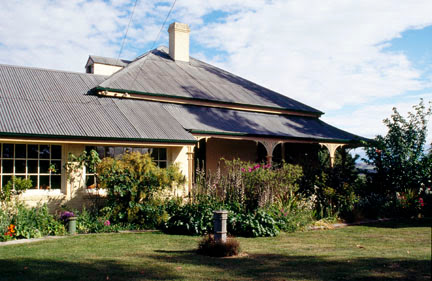 |  |
- Large one storey house of painted brick with hipped roof and later, Victorian, verandah on two sides. House has French doors with shutters along front, with central double front doors, sidelights and flat arched radial fanlight.
- Windows at sides have twelve panes. Verandah has cast iron brackets and wooden posts. Dormers have been added later. There is also a painted brick stable building with pilasters, freize, twelve pane windows and gabled roof.
Lived at Illaroo:
1. Petre Isaac (Peter) DE BOMFORD b.19 May 1834, Lake River, Tasmania, Australia d.19 July 1910, 293 Brisbane Street, Launceston, Tasmania, Australia buried at Cypress Street Cemetery, Launceston, Tasmania, Australia  | Tragedy At Illaroo The Tasmanian (Launceston, Tas.) Sat 6 Sep 1879 Page 7 The Tasmanian (Launceston, Tas.) Sat 6 Sep 1879 Page 7 About noon on Monday the whole town was electrified by a report that Mr. Peter Isaac de Bomford, of Illaroo, shot his sister-in-law, Mrs Emily Easton. The first intimation received in reference to the shocking tragedy was a hasty message for Dr Hardy, requesting him to go out to Illaroo to attend Mrs. Easton, who had been shot by her brother-in-law, and Sergeant Murphy brought the news to Chief District Constable Propsting in the Police Court. Mr Propsting immediately drove out and also Dr Hardy, but Mrs Easton died a few minutes after being wounded. The circumstances of the case are singular and go to prove either that a great error has been committed in having allowed Mr de Bomford to remain at large in a state of aberrated intellect, without proper restraint, or a most deliberate and premeditated murder has been perpetrated. The deceased had been living with her sister-in-law, Mrs de Bomford, at Illaroo for many years, was beloved by all the family, and exercised valuable influence over Mr De Bomford. |
- Their three children were:
1. Edwin Frederick Serrell de Bomford, 1861 - 1954, aged 93.
2. Mervyn Charles de Bomford, 1863 - 1908, aged 45.
3. Everard James Bomford, 1864 - 1922, aged 58.
- Everard was born in Tasmania to Petre Isaac de Bomford and his wife Elizabeth Hopkins.
- He had two brothers Edwin and Mervyn, and the family lived at 'Illaroo' off the Blessington Road past St Leonards.
- Everard became a journalist for the Tasmanian News and had an office in the Quadrant. Read more...
- He later moved to Launceston, where he lived until his death. He was a brother of the late Mr. Peter Bulman, who will be remembered as in early association with the Waverley Woollen Mills, and his only son was Mr. William Bulman, a marine engineer, who was lost with Messrs. W. Holyman and Sons' steamer, the Orion. Mr. Bulman's wife pre-deceased him, and he leaves a daughter, Miss Agnes Bulman. - The Mercury (Hobart, Tas. : 1860 - 1954) Wed 1 Oct 1879
- Tasmanian Heritage Register Place ID #3869
- back to Contents
89. St Michael's Collegiate School, 212-218 Macquarie Street, Hobart
 |
| Collegiate School 1927 |
- Main building also known as Stephenville, 218 Macquarie Street
- Listed on the Register of the National Estate
Former home, built for Alfred Stephen, Solicitor General for Tasmania (later Chief Justice of NSW), in 1825.
- Leased to government from 1840 for 5 years, used as Queens School to early 1844.
- Official residence of Catholic Bishop until 1872. In school use since c1880 (see below).
- Balancing wings and Doric portico give grandness to the building which continues in use as part of a school complex.
- The immediate front curtilage with stone walling and mature plantings is important in providing a fine setting for the building. With building group opposite, defines an historic precinct.
|  | ||||
|
|
- Front portico is full length across original building and held by wings: features fluted Doric columns with cornice and balustrade to terrace over. Pilasters to front facade main building. Hipped iron roof forms. Mature trees in front. Stone wall and pillars to street.
- Sister Phyllis became the Principal in 1895, by which time the number of enrolled students had risen to 71, including 6 boarders. To cater for this growth in numbers the school moved to 'Stephenville', a large house in Macquarie Street.
- The School has since expanded on to several campuses, although Collegiate is essentially a city school. By the 1990s the School was educating just over 1000 students from Kindergarten to Year 12. Read More: Companion to Tasmanian History
- Tasmanian Heritage Register Place ID #81
- back to Contents
90. Islington, 321 Davey Street, Hobart, TAS, Australia
- Listed on the Register of the National Estate

Islington Hotel, 321 Davey Street, Hobart
- The austere detailing gives the building a unique character. Austerity continues into treatment of garden.
- Addition of an old portico has changed the reference for the house which now has two 'fronts' fighting for recognition.
- Built by Mrs Sarah Hodgson. Stuccoed in c 1877. Portico from No. 142 Macquarie Street.
- Evidence suggests that the house now known as Islington was built in 1847. The property was recorded by James Sprent in the course of a comprehensive survey of the town in July 1847.
 |
| Heritage Register photographs |
- It is an example of Regency style, relatively unusual in Hobart which is better known for its Georgian architecture.
- Other Tasmanian examples of Regency style include Panshanger near Longford, the Courthouse at Richmond, Lake House near Cressy, and Beaulieu and Runnymede at New Town, all erected before 1840.
- Islington also provides an interesting contrast to neighbouring houses which were built at about the same time - (Hobart Town Courier 27 September 1848)
- The house was not called Islington until about 1899 but there is no evidence that the house had any other name.
- The Ionic portico is also a later addition: once on 142 Macquarie Street, it was re-erected here by Peter Stops.
- The accommodation was less extensive originally, offering ten rooms that presumably comprised the present six main rooms downstairs plus the hall, and the three bedrooms upstairs in the central block.
- The attic bedrooms with dormer windows in the southern wing were probably constructed at a later date but photographic evidence is not adequate to establish a date for this prior to the 1890s. These were replaced by a first floor extension c. 1930.
- Heavy simple mouldings include corner pilasters to wings and two storey central pilaster to central section, parapeted gable-ends, strings and gable apex caps. Broad flat chimney. Portico with Ionic columns to east wing was originally on 142 Macquarie Street.
- Read more: Islington: The House and its occupants; Tasmanian Heritage Register Place ID #3097
- - back to Contents
91. Old Wesleyan Chapel (former) now Hall, 12 King Street, Campbell Town, TAS, Australia
A simple chapel like many to be seen in Cornwall, England, and typifies the faith of the Wesleyans.- An early Wesleyan chapel which is a significant example of Colonial architecture.
- Featured by Hardy Wilson in his "Old Colonial architecture in N.S.W. And Tasmania".
- The semi-circular headed windows are characteristic of the Georgian style and the central entrance, with its fluted pilasters and fanlight, is a fine specimen of its type. The broken-hipped roof is unusual.
|
| ||||
|
|
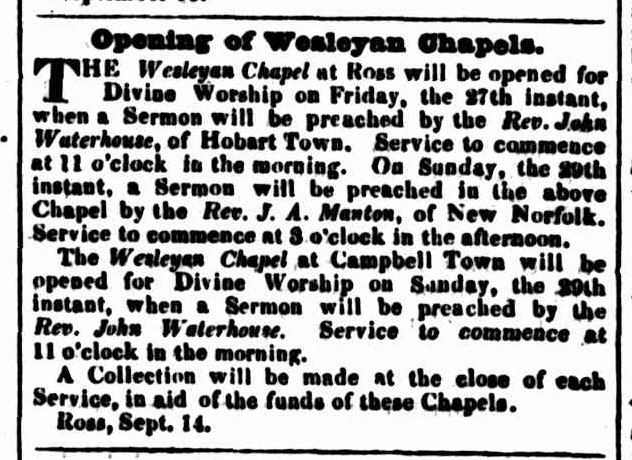 |
| Hobart Town Courier, 20 September 1839 |
A freestanding brick building with a broken hipped galvanised iron covered roof.
- Main elements are the large semi circular headed windows, either side of central doorway and along both side elevations.
- Doorway has fluted timber pilasters either side of a diagonally boarded six panel door, with semi circular fanlight over.
- Simple interior with a gallery at rear supported on square timber columns.
- Approximate site of the first chapel, built and opened in 1839. Seven years later, a second chapel was built in front of the original building.
- It was built in front of the old chapel in 1846. It was much larger than the first, measuring 46 by 27 feet, and its furnishings were all of cedar. A large gallery was erected across the back of the building in the following year.
— The Mercury, 7 January 1940. - Read more: Cemeteries, Churches and Things
- Tasmanian Heritage Register Place ID #4967
- - back to Contents
92. The Portico, Sunnyside, Swanston Street, New Town
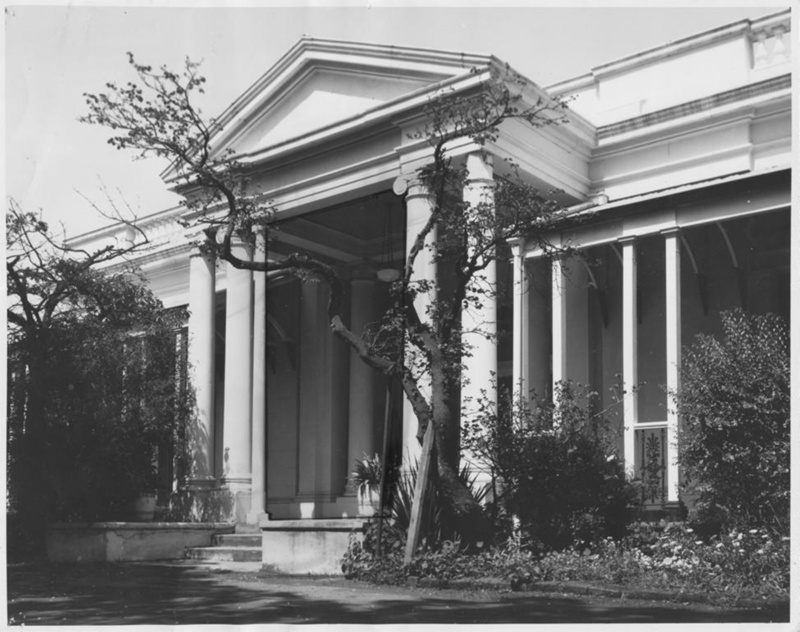
An unusual example of a Roman Revival villa with classical portico and encircling verandah.
- Built about 1845, the house appears to include an early cottage. It has been sympathetically restored during which Doric columns were substituted for the original Ionic columns. It has a fine garden, and the fine, private, main part of the building is of considerable architectural interest.
- Sunnyside was mainly built in the mid-1840s, but it incorporates a cottage that dates from some ten years before.
- The land where Sunnyside stands was part of 5 acres that were conveyed to Samuel Carr, Esq in September 1835. Carr built a 'dwelling house' on the land which had a series of short-term owners before Thomas Daniel Chapman purchased it for ₤1,050 in May 1843.
- Chapman appointed William Porden Kay, the colonial architect, to design Sunnyside.
- The building's main façade and its impressive entrance face east towards Park Street where the property's main access used to be. (Following subdivision of the property in the 1940s, Sunnyside is now accessed from Swanston Street, at the rear of the property.)
 |  |
 |  |
 |  |
 |  |
- The faade essentially is Neo-classical in the Greek Revival Villa style popular in Europe during the Regency period and considered the last of its genre built in this State.
- A dual access driveway sweeps around the attractive fret worked and flag stoned trellis verandah on three sides of the villa to a commanding Tuscan portico with towering columns and tympanum above.
- Then, a leadlight entry with doors with a beautiful stained glass lunette window over and which open to the most stunning of reception halls with a combination of Regency and Italianate architectural features.
- It has a towering barrel vaulted ceiling with roses and a chandelier, the walls have reeded pilasters extending through the vaulting, the curved corners have display niches, the floor is Baltic pine and it continues through double doors with another glazed lunette above, into a capacious rear foyer.
- On either side of the hall are two large living rooms, three of which have fireplaces with marble mantels imported from England.
- With similar period features and inter-linking, there's a music/drawing room and a library, each with coalgrate fireplace and a marble mantel.
- The formal dining room has a coalgrate fireplace with a timber mantle, polished Baltic pine floor, rose and chandelier, a window with French doors to the verandah. There is a door through to an early 20th century family...
- Tasmanian Heritage Register Place ID #2757
93. Town Hall, Macquarie Street, Hobart
The Town Hall auditorium seats up to 300 people and is a popular location for meetings, wedding receptions, fairs, concerts, conventions and formal dinners for up to approximately 130 people- Hobart Town Hall, erected between 1864-1866, is important as the first permanent council chambers for Hobart Municipal Council.
- Designed by noted architect Henry Hunter, to complement the adjacent Royal Society of Tasmania Museum, the buildings of the Town Hall signify the establishment of municipal government in the Colony of Tasmania.
- The site is associated with the first and second Government Houses established in 1804 and 1811 on the prominent site selected by Lieutenant Governor Collins at the head of Sullivan's Cove.
- Until 1857 the area was the administrative and residential centre of the Lieutenant Governor of Van Diemens Land.
 |  |
 |  |
- The Town Hall housed the office of the Southern Tasmanian Federal League for the duration of the campaign and was the venue for a number of crowded public meetings organised by this organisation and its rival, the Federation with Safety and Advantage League.
- On 1 June 1898, the Town Hall was the site at which the Tasmanian Premier, Sir Edward Braddon, delivered the culminating speech of the campaign in favour of federation.
|
|
- The Town Hall has strong, ongoing associations with the Hobart community and is important as a place highly valued by the community for its symbolic, cultural and social associations. (Criterion G.1)
- In 1858, when the city was incorporated, meetings were still held in temporary buildings. A competition held in 1861was to determine the future design of the Town Hall. Henry Hunter, who had designed the adjacent museum, was invited to produce the final design for the new Town Hall. Hunter's design for the Town Hall is said to have been influenced by the Palazzo Farnese in Rome.
- The building was to align with the adjacent Royal Society of Tasmania Museum and due regard was to be paid to the Argyle and Davey Street frontages as well as the two main frontages to Macquarie and Elizabeth Streets.
- In 1863 the Government notified the Council that it disapproved of the plans for the Town Hall on the grounds that it included new Police Buildings. The approved building works omitted the service wing on the Cove side of the site.
|
|
- The stone for the buildings came from two separate sources: a quarry at Knocklofty, and a new quarry on the Derwent River, near Bridgewater. The first section erected included the Argyle Street wing fronting on to Macquarie Street.
- Tenders received in 1866 for the remainder of the building included one from Gowland and a second from Wiggins. The new contract was awarded to Gowland.
- In 1871 a stone wall was erected around the boundary, with trees obtained from the Botanical Gardens for landscaping.
- Read more: On the Convict Trail; Hobart City Council; Organ History Society
- Tasmanian Heritage Register Place ID #2466
- back to Contents
94. Parliament House, 2 Murray St, Hobart, TAS, Australia
Presiding over an oak-studded park adjacent to Salamanca Place, Tasmania’s sandstone Parliament House (1840) was originally a customs house.Parliament House was originally designed as the Customs House in colonial Georgian architecture style by skilled convict architect John Lee Archer in 1830.
- The site for the building had originally been a market, but had been converted into timber yards in the 1820s. The site was reserved in 1832 for the building of a customs house due to its close location to the wharves of Sullivans Cove (the building was originally closer to the water's edge than it is today following further reclamation).

Parliament House decorated in 1901 for Australian Federation celebrations. - Between 1832 and 1840 golden honey coloured sandstonewas quarried from locations in the Queens Domain andSalamanca Place (now the site of Salamanca Square), and a small railway was constructed to ferry the blocks to the construction site.
- Construction began in on 5 January 1835, and using mostly convict labour, the basement level had been completed by March 1836.
- By 1838 the second story had been added and the building was ready for staff of the Customs Department to move into on 1 September 1840.[2]
- At that time, the Legislative Council, which had been formed in 1825, were meeting in a room adjacent to the oldGovernment House, but the location was less than adequate for such meetings.
- It was proposed that the meetings should be held in the spacious new 'Long Room' of the Customs House, and 19 June 1841, the first Legislative Council meeting was held within the building.[2]
- The new House of Assembly met in the Long Room, where the Legislative Council had previously met, and the Legislative Council moved into a new ornate Chamber, where they still meet today.[2]
- Between 1938 and 1940 Parliament House was again renovated to construct a new chamber for the House of Assembly, and convert the Long Room, where they had been meeting for the previous 82 years, into a Member's Lounge.
- The new House of Assembly Chamber was formally opened on 14 May 1940, whilst Tasmania was involved in Australia's World War IIcommitments. In December 1940 extensions were also added to the Legislative Council Chamber to create the Murray Street wing.[1]
|
|
- There’s a tunnel under Murray St from Parliament House to the Customs House pub opposite: the official line is that no one knows what it was used for, but we'd hazard a guess… Public 45-minute tours run when parliament isn't sitting. (Lonely Planet)
History
Van Diemen's Land was made up of two colonies, the north and the south, which were both run from Sydney.- The two colonies became one in 1812 and Van Diemen's Land became a separate colony with its own governing body in 1825.
- In 1850, the British Parliament passed the Australian Colonies Government Act, giving Van Diemen's Land its first representative government. The membership of the Legislative Council was increased to 24; eight of these members were chosen by the Governor and 16 were elected by adult men who owned land or paid rent in the colony.
- In 1854, the Constitution Act was passed by the Legislative Council, giving the colony responsible government and a bicameral parliament. It was given royal assent in 1855.
- The first Tasmanian Parliament opened in December, with Mr WTN Champ as the first Premier.
- There are currently 15 Members of the Legislative Council (MLCs), each from single-member electorates. Members of the Legislative Council are elected, via a preferential voting system, for six-year terms. Elections are held annually on a rotational basis, with three members elected one year and then two the next, and so on.
- There are 25 Members of the House of Assembly (MHAs). Each of the five electoral districts is represented by five members for a term of up to four years.
- Members of the House of Assembly are elected using a type of proportional representation known as the Hare-Clark system. Voting in Tasmanian State elections is compulsory for all citizens aged 18 years or over who have lived in Tasmania continuously for at least six months.
- By 1903, all adult men and women in Tasmania could vote in House of Assembly elections but it was not until 1968 that the same rights were introduced for Legislative Council elections.
 |  | ||||
|  | ||||
|
|
- Two storey stone with slate roof in Colonial adaptation of early renaissance Florentine Palazzo style. Banded rustication to first floor with fine ashlar work to second floor. Central entry arcade with parapet cornice and coat of arms.
- String courses emphasise horizontal line of building. Pilasters to break fronts 9 x 12 pane windows. Fine interior chambers. Mature park trees.
- Read more: Wikipedia; Parliament of Tasmania; School Curriculum
- Tasmanian Heritage Register Place ID #2525
- back to Contents
95. The Anglican Church of St Thomas, Avoca

A number of historic buildings exist in the small town of Avoca, including the St Thomas Anglican Church completed on 8 May 1842, and the parish hall completed around 1850.
- Most prominent is St Thomas’ Anglican Church (Romanesque Revival style), designed by James Blackburn, who also designed the church at Port Arthur; consecrated on 8th May 1842.
- Three wealthy men, Mr Simeon Lord, Humphrey Grey and Captain William Grey, stood as guarantors for the cost of the building. Some of the pews still carry their original numbers and at the back of the church is a large pew built for a particularly large church warden.
- The former Rectory is on the western bank of the St Paul’s River.
 |
| Interior of St Thomas Church |
- St Thomas’ Anglican Church was built in the 1840s, the first baptism recorded is that of Charles Berwick on 1st October 1841.
|
| ||||
|  |
- Ashlar stone Romanesque church. Continuous parapet and cornice. Nave of four bays - round head 32 pane windows. Round head doors. Large east window in three parts. Six panel flush door with solid fanlight.
- Two level square tower with bellcote. Prominent location on knoll at west entry to town.
- Restoration Works 1995 Bell Tower Lantern.
- Tasmanian Heritage Register Place ID #4880 St Thomas' Anglican Church
Rectory (Former), Esk Main Rd (Off), Avoca, TAS, Australia
 |  |
 |   |
- Single storey brick Georgian cottage. Round head doorway with heavy casing - four panel door and radial fanlight. Twelve pane windows. Iron hip roof. Old picket fence. Hillside location on opposite side of river to Church.
- Read more: Heritage Highway, Avoca St Thomas's Church; Fingal Valley; TasphotoAlbum: Avoca; Avoca: A brief History
- Tasmanian Heritage Register Place ID #4879 Former St Thomas' Rectory;
- back to Contents
Addendum:
Bona Vista, Outbuildings and Setting, 75 Storys Creek Road, Avoca, TAS, Australia
- Listed on the Register of the National Estate
- Listed for Sale Sept 2015 asking $1,750,000
- Old Listing: Bona Vista Farm November 2012 asking $3 million+.Grazing property totals 2,014.55 hectares (4,976 acres) and contains 7 Land Titles of which 635 hectares are arable (1,568 acres) leaving 1,379.55 hectares (3,407 acres) of native grasslands, unimproved run country and native open forest.
 |
| 'Bona Vista' Homestead - 100 Hectares |
- The residence enjoys original characteristics with stone and timber floors, open fire places, shuttered double hung windows and cedar doors, mantelpieces, architraves and skirtings.
- Accommodation includes 5 bedrooms, a study and 3 bathrooms enhanced by an extensive ballroom and adjoining dining room.
- Bona Vista, Avoca, Tasmania, is noted for it's very high sandstone walls and elaborate out buildings.
History of Bona Vista
The original residence was erected on land granted to Simeon Lord, a wealthy Sydney capitalist of the period. Simeon lord had arrived in Sydney as a convict in 1791.- Simeon Lord Jr took up residence with his new wife at Bona Vista in 1831.
- The property was used as a summer residence, with the family based at 'Vaucluse' in Macquarie street in Hobart.
Bona Vista was one of the finest homes in the colony, and was the centre of social life in the area.
- In 1862, the 11,374 acre property was put up for sale, and from 1873-1921 it was occupied by the Rigney family. Bona Vista was then purchased by Mr R. G. Marshall of Tullochgorum.
- The house has not been occupied since 1959, though the surrounding farming and grazing lands are still used. From 1990 it has been modified for use a conference centre, and now recently renovated.
- Comprising house and adjoining courtyards and outbuildings; remnant early garden; paddocks and farmyard areas immediately adjacent to the courtyards to the east and west; and the paddocks south of the house to the South Esk River, off Storys Creek Road, 1.5km north-west of Avoca.
- The property is noted for it's very high sandstone walls and it's elaborate out houses. Part of the stone wall is the arch made of sandstone leading to the house.
 |  |
 |  |
Significance
Bona Vista is a Tasmanian pastoral property set up in the 1830s which displays the wealth and opulence of the early traders, merchants and pastoralists of eastern Australia (Criterion A.4).- The place is important for its close association with Simeon Lord and his descendants.
- The house was built by Simeon Lord Jnr on land granted to his father, Simeon Lord, who arrived in New South Wales as a convict in 1791 and rapidly became one of the early colony's richest businessmen (Criterion H.1)
 |  |
 |  |
- The Old Colonial Regency house demonstrates quality nineteenth century workmanship through its elegant detailing and fine stone work (Criterion F.1).
- Bona Vista is set in a dramatic landscape of mature trees, on a prominant hillside which overlooks Avoca township. The early house in its setting was painted in watercolours by Emma von Stieglitz in 1836 (Criterion E.1).
 |  |
 |  |
Bona Vista property
Bona Vista is an early pastoral property near Avoca in the Fingal valley. The group of buildings is set on a Hillside overlooking the Esk River and surrounded by its original farming and grazing lands.- Groups of trees within the garden are visually linked to the adjacent landscape by windbreak plantings and the tree lined driveway. These project down the hillside creating a dramatic setting for the house at the focal point of the converging lines of trees.
- Their projection into the landscape also frames the panoramic view from the house and focuses attention on the township of Avoca, the confluence of the two rivers, and the backdrop of distant hills and Valleys.
- The residence is a single storey Old Colonial Regency house of fine stonework, with an iron hip roof. The house adjoins a group of large stone walled courtyards, with a central stone barn of two stories with integral skillions.
- The buildings were erected in stages from about 1832-1848 as follows: c1831 -cottage with four main rooms and attic; c1836 cottage extension to provide large formal room; c1839 courtyard and kitchen wing; 1848 -new house wing containing drawing room and ballroom.
- Many of the house interiors are still intact. The barn was erected in 1836 and extended in the period 1840-55.
- Properties of a similar age, such as Brickendon at Longford, Beaufront and Somercotes near Ross, and Panshanger Between Cressy and Longford, all have courtyards or walled gardens.
- As well as sheltering young stock and kitchen gardens, these courtyards provided security from outlaws on the large, convict-staffed estates of the period.
- To provide additional security, all window openings outside the courtyard have internal shutters with locking bars which are still in place.
 |
|  |
- Read more: Bona Vista beauty in Avoca; Lord Family History.Tasmanian Heritage Register Place ID #4883

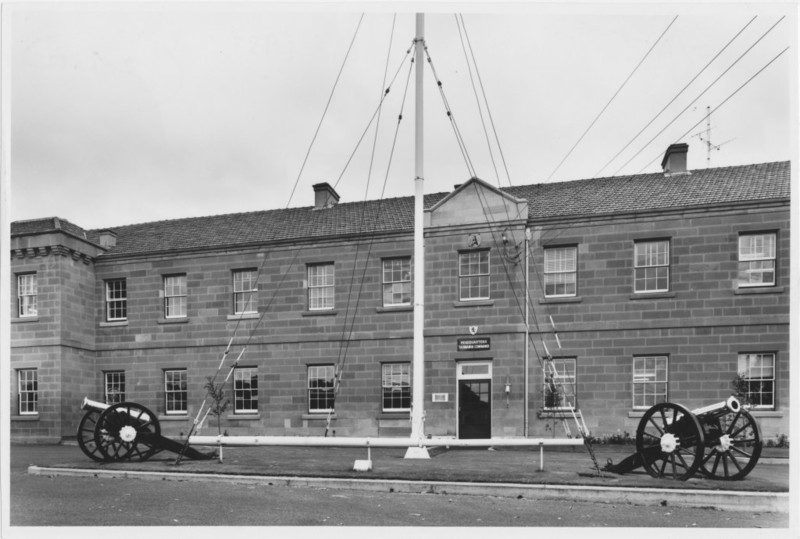






![St Mark's Anglican Church, Pontville : exterior [photograph by Trevor Bunning (2009)] St Mark's Anglican Church, Pontville : exterior [photograph by Trevor Bunning (2009)]](https://blogger.googleusercontent.com/img/b/R29vZ2xl/AVvXsEhB62uy6dwH2BUgPWIjnSMF5-ZNowQ8_sqHOiOQi0rP8uHmoBxW1rb7U9qYU3s-Ody2PbXSZQf8sI7_nlMTn1ALF3KzAiJwcsi0MqFVjZkWzPSmwHguzkaCZeM9pFv2LdSS7DABFRDr6GFI/s567-Ic42/Pontville3.jpg)
![St Mark's Anglican Church, Pontville : interior [photograph by Trevor Bunning (2009)] St Mark's Anglican Church, Pontville : interior [photograph by Trevor Bunning (2009)]](https://blogger.googleusercontent.com/img/b/R29vZ2xl/AVvXsEjDlqgSzRwaMWb6bi9PqQ_LB4qrrrVp_kPRoeDu2QVu314ySCUdnzZxZlcSN9UuRExuzTE00QF6K9uEAUDEWlIohHrzscavT1pSNgm6aOLt6NVPEfotUJI9tiOBTO8j0Mfwmh5k8uzOVszJ/s567-Ic42/Pontville6.jpg)
![St Mark's Anglican Church, Pontville : exterior [photograph by Trevor Bunning (2009)] St Mark's Anglican Church, Pontville : exterior [photograph by Trevor Bunning (2009)]](http://www.ohta.org.au/images/Pontville2.jpg)












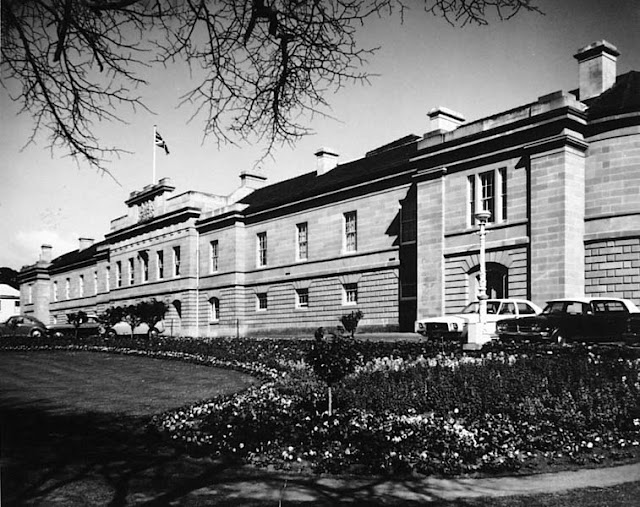








Jon Ruwolt, you have violated my copyrighted material from my Thomas J. NEVIN web sites about the BAYLEYS of RUNNYMEDE, Tas and posted our article, word for word plus our photos at your Federation House Wiki. REMOVE OUR MATERIAL YOU HAVE STOLEN FROM THE WIKI. WE WILL NOT TOLERATE YOUR BLATANT DISREGARD OF COPYRIGHT.
ReplyDeleteJo per admin for KLW NFC IMPRINT